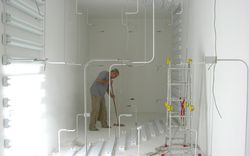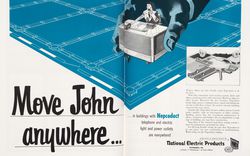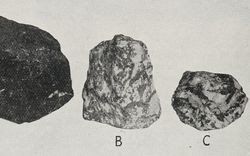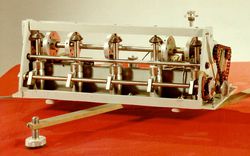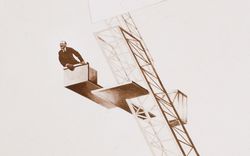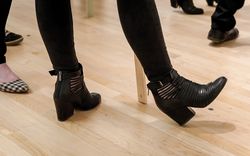Controlling Comfort
Text by Manfredo di Robilant
Throughout the twentieth century, the dramatic increase in the number and complexity of technical systems in buildings has proven critical for the buildings themselves as well as for their users and dwellers. Electrical lighting, heating, air conditioning and telecommunications created the need for more “technical” space. This need led to building elements such as dropped ceilings and floating floors, and to the consequent dilemma of whether to hide or show utilities. Technical systems crucially contributed to the expectation of a controlled environment that could ensure well-being, or “comfort” (a buzzword in disciplines related to building since the 1960s). North American architecture in the mid-twentieth century offers case studies that illuminate the issues raised by the wide diffusion of technical systems.
Consider two advertisements, the first by the American Iron and Steel Institute and the second by the National Electric Products company, published in Progressive Architecture in January 1951 and February 1953 respectively. This US monthly, together with the competitors Architectural Forum and Architectural Review, formed a sort of triptych on the bookshelf of any North American architect aspiring to be “Modern”, whatever that meant. In this triptych Progressive Architecture was recognizable for advocating the most international currents in the profession.
Read more
The aim of the first advertisement was to promote the use of steel pipes in radiant heating systems, with special attention to school buildings. The advertiser was the association of US steel producers, the Committee on Steel Pipe Research, founded in 1908. The image well reflects the optimism of a booming economy: with curiosity in his eyes and happiness in his smile, a schoolboy of second or third grade is depicted intervening in class. From the slogan we learn he is called Johnny. Despite the snowy landscape in the background, little Johnny wears only a short-sleeved T-shirt. The window in his classroom has a light frame, probably made of metal, and consequently offers very low insulation. Johnny’s well-being relies on the performance of the radiant heating system hidden in the floor or ceiling of his classroom.
The second advertisement is by a private company that no longer exists and that was based in Pittsburgh. The goal was to promote “Nepcoduct”, a system of raceways for electric and telephone cables conceived for use in new office buildings. A giant hand, a baleful embodiment of corporate power, moves a clerk on an office plan like a pawn in a chess game. The slogan emphasizes the flexibility allowed by Nepcoduct in organizing the layout of office space: “Move John anywhere”.
In a surprising flash-forward we can imagine again meeting Johnny, now a young adult who recently entered the job market as a white-collar employee. He left the suburban surroundings of his panel-heated primary school and now works in an office building in the dense city centre. Technological systems are always there with all their amazing power, though now John seems not a beneficiary of progress but a victim of it. The explanatory text mentions the owners of the building where John works, as well as the tenants, the architects and the builders. They are all supposed to be interested in the virtues of cheapness and flexibility offered by Nepcoduct. On the other hand, the mass employee John loses any residual autonomy in front of his corporate employer thanks to the performance of the cables embedded in the floating floor.
The performance of buildings post-WWII became an important issue in the architectural debate, particularly in North America. Buildings were criticized not only on the basis of “intrinsically architectural” features such as how forms and functions interact within a building and how the building interacts with its surroundings. Buildings started to also be judged as machines that produced an interior environment where air and light were controlled. This expectation was stronger in the case of non-residential buildings, since comfortable working conditions were considered crucial to efficient production, either in factories, offices or selling spaces.
On the other hand, the same expectation was present in the residential sector. “The American Style has hidden Performance” was stated in October 1950 in the popular monthly House Beautiful, dedicated to the interior decor of homes. This journal was rather unengaged in the struggle to disseminate architectural forms that could be considered properly “Modern”, although it advocated a new style that identified with the triumphant postwar United States. In House Beautiful’s vision, “American Style” had to be based on the performance of technological systems embedded in homes, and thus on the comfort of the dwellers.
The 1940s and 1950s in America were a time of great expectation from architecture and particularly from the advancement of building elements and technical systems. Environmental concerns were yet to come and industrialization was not shadowed by fears of overproduction. “The producers in America . . . are in a unique position to influence contemporary architecture” proclaimed the January 1948 editorial in The Architectural Review.
The contribution from other industrial sectors was made possible by diffuse confidence in technological progress. The meeting of architecture and industry dreamed of by the European avant-garde of the 1920s and 1930s eventually happened, although not through social engineering or revolution as they wished, but through the market.
The third advertisement belongs to a series by Chrysler Airtemp; it was published in Progressive Architecture in November 1946. Chrysler Airtemp was a branch of the Chrysler Corporation that transferred the progress made in automotive air conditioning to the building market. The slogan emphasizes the improvement brought by air-conditioning to the productivity of white-collar employees. If we allow some freedom in John’s imaginary biography from the succession of journal issues, we can imagine him working in this office after having left the big corporation in the centre of town. The new office is small and maybe not far from the old school in the sprawl, but technology is again there to make him a productive worker rather than a curious schoolboy.
In the 1950s, technological systems in North American white-collar working spaces played a twofold role. On the one hand, they led to well-being that was unimaginable before and to complete independence from weather conditions; on the other hand, they contributed to limiting the individual autonomy of workers. Comfort and control went one behind the other, as Johnny–John suggests.
Manfredo di Robilant was a Visiting Scholar at the CCA in 2012.
